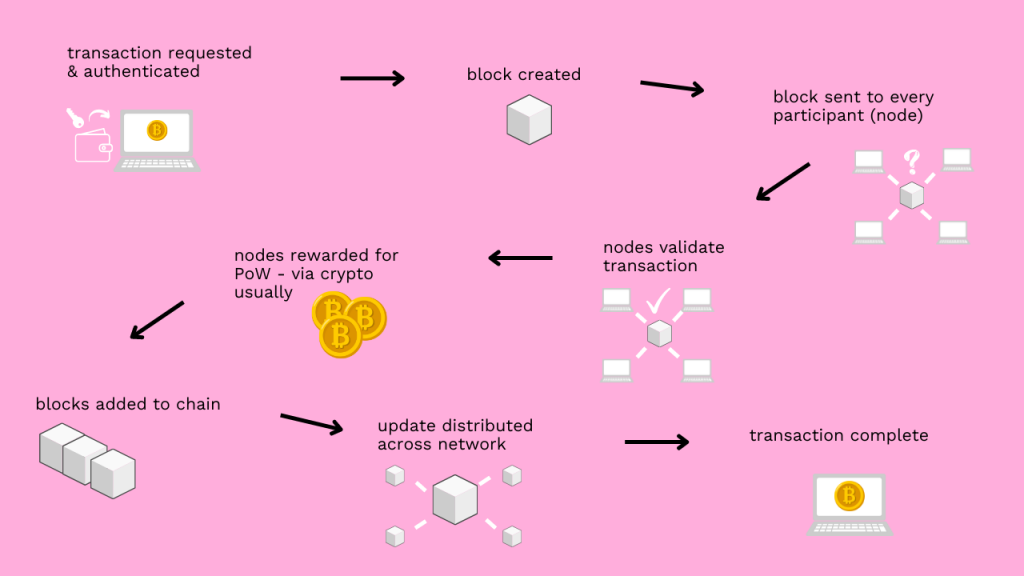Proof of Work vs Proof of Stake | Consensus Mecha-what?
Want to take a look under the bonnet of the blockchain and see what makes it run? We’re breaking down the concept of a consensus mechanism, and the differences between the various kinds used by popular companies.
If you’ve read the words “consensus mechanism” and already feel out of your depth – don’t worry. This article will break down, in pleasantly simple terms, exactly what a consensus mechanism is, what they do, and why they’re important. You’ll also learn about Proof of Work vs Proof of Stake, and the pros and cons for each.
And, just so you’re not scared away, it’s actually not as complicated as it first sounds!
If you’re someone who considers themselves somewhat of a technical wizard and blockchain brainbox, this one may just be a gentle reminder for you.
Table of Contents
What Is a Consensus Mechanism?
Proof of Work
Proof of Stake
Wrapping Up
What Is a Consensus Mechanism?
You might also hear these being referred to as consensus protocols, but a consensus mechanism is the process that adds new data (or blocks) to the blockchain. They’re what make up the inner workings of this mystifying new technology, and are a crucial part of the whole operation.
The blockchain, a distributed ledger, is a database that cannot be kept or maintained by one person or organisation. This avoids any large errors, or shady goings-on. Instead, it’s run by a network of users and computers.
In order for new transactions to be added to the blockchain, a consensus must be met. This means that everyone is on the same page about what’s going on. So, if someone tries something fraudulent, they’ll quickly be sniffed out, and the shady transaction won’t go through.
So long as legitimate users control more of the network than bad actors, everything is safe. That means fraudsters would need to gain control of at least 51% of the network – which is nigh on impossible, it’s so difficult.
There are surprisingly a lot of different consensus mechanisms, but we’re going to focus on just two. These two are perhaps the most well-known, and are ones used by some of the largest blockchain companies in the world. It’s Proof of Work vs Proof of Stake.
Proof of Work
The Proof of Work (PoW) protocol is one used by huge blockchain companies like Bitcoin and Ethereum. It’s also the first consensus mechanism to be used in blockchain technology. It was actually originally introduced as far back as 1993, but was reintroduced in 2008 by Satoshi Nakamoto, the creator of the Bitcoin network.
PoW is a decentralised mechanism that requires members of a network to exert considerable effort in order to solve complex mathematical puzzles, whilst preventing bad actors from overtaking the network. It’s widely used for mining cryptocurrency, verifying transactions, and mining new tokens.
Thanks to PoW, crypto transactions can be processed in a peer-to-peer manner, without the need for third party intermediaries. That’s what makes it decentralised.
How does PoW work?
This helpful video from Whiteboard Crypto breaks down what PoW is, and exactly how it works. If super technical explanations aren’t your forte, the illustrative explanations should help here!
If the idea of a decentralised ledger is for everyone to have a copy of the database, that matches with everyone else, then there needs to be a way to make this happen. Proof of Work is the answer to this.
PoW is a system that uses a significant amount of effort to deter or eliminate fake uses of computing power. When launched on the Bitcoin network, it was designed to solve the issue of “double spending”. Double spending is bad because it results in duplicate coins, reducing the value of currencies.
This consensus mechanism is used to add new blocks of transactions or functions to the blockchain securely, reliably, and efficiently. So, when Proof of Work is happening, what is it actually doing?
To verify a block and add it to the blockchain, computers will undertake random mathematical guesswork in order to solve a problem. Computers will keep guessing until they land on the right answer, aka the password for that block. This guesswork is a “hash” function, which is very technical but important to PoW.
Once a user has correctly guessed the password of a block, they’ll be rewarded in cryptocurrency for their work, which they now have proof of… see where the name comes from?

Problems with PoW
When looking at Proof of Work vs Proof of Stake, it’s important to look at the problems thrown up. Although some of the largest blockchain companies use PoW, it is flawed and unsuitable for mass adoption. The first major problem, which you’ve probably heard plenty about already, is its negative impact on the environment.
PoW is incredibly energy hungry, thanks to the huge network of computers constantly expending lots of effort to solve problems. Some of the energy usage stats for crypto companies are staggering. In fact, the energy usage of PoW is larger than the country of Switzerland. Plus, as the network grows, the more computers are added, meaning higher energy consumption.
Some companies are utilising greener energy sources, like solar, to power their mining facilities. However, there’s still a long way to go before Proof of Work itself can be thought of as green.
Another issue with PoW is scalability. As the network grows, it becomes more congested. At high congestion times, transaction fees ramp up. This means that you could be sending someone $10 worth of crypto, but having to pay $20 worth to send it.
These scalability issues also mean that, in lots of cases, networks are controlled largely by just a few big companies (since they can afford all the computing power it takes to mine crypto), making it more centralised.
Proof of Stake
As discussed above, Proof of Work isn’t without its problems, despite being used by some of the largest crypto companies in the world. That’s why an alternative consensus mechanism was developed: Proof of Stake (PoS).
To explain exactly how PoS works, Whiteboard Crypto has created another informative video!
This video first explains the concept of staking, then how the Proof of Stake mechanism works. It’s a much more energy efficient and less risky alternative to the more common PoW mechanism.
How does PoS work?
First, let’s break down the act of staking. Unlike Proof of Work, PoS relies on one single validator (or miner) to solve the complex cryptographic puzzle which lets new blocks be added to the blockchain. In order to be chosen as a validator, users must lock up some of their cryptocurrency as collateral.
This means that if they fail to guess the puzzle’s answer, or don’t play ball, they will be penalised by having some of their collateral taken away. Similarly, if they guess correctly, they’ll be rewarded. This locking up of collateral is called “staking”.
Validators are picked based on a few things:
- How much they’ve staked
- How long they’ve been staking for
- Some level of randomisation
The randomisation aspect helps to avoid large companies with big budgets getting picked every time. This avoids things becoming too centralised, like Proof of Work (because bigger companies can solve puzzles faster with more computational power).
Benefits of PoS
Since only one validator solves each block’s puzzle, there is far less need for computational power. This means less energy consumption, compared to Proof of Work.
Another benefit is that, because validators have incentive to correctly verify the blockchain, things are much more reliable. If a validator gets things wrong, another validator will be brought in to check things and try for themselves.
Drawbacks to PoS
It wouldn’t be fair, when looking at Proof of Work vs Proof of Stake, to not look at Proof of Stake’s downsides. There are a number of risks involved with PoS, from the perspective of a would-be validator.
There is something called the “locking period” when you go to stake your coin. It’ll be moved into a locked state, which might be required for a month, or even up to a year. During this time, you won’t be able to move these coins, which is always a risk.
Another drawback is that there is a level of technical knowledge required. Validating transactions often requires some knowledge around coding. Without some complex knowledge, you might not pick up on mistakes. This could lead to you being penalised, and losing your coin.
Wrapping Up
No blockchain can function without a consensus mechanism. Hopefully now, you understand a little better how they work, and the role they play.
With technology advancing rapidly all the time, some of the major companies are already looking at switching from the energy hungry Proof of Work mechanism. More environmentally friendly options are being explored, in order to make crypto a viable part of the future.
Updated November 2022: Since “the Merge”, Ethereum now utilises the Proof of Stake consensus mechanism, cutting its energy usage by over 99.9%.
